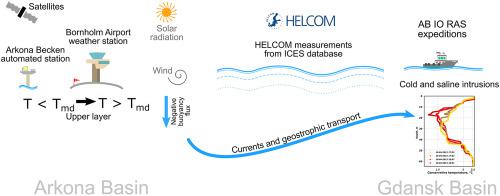Estuarine, Coastal and Shelf Science ( IF 2.6 ) Pub Date : 2020-12-10 , DOI: 10.1016/j.ecss.2020.107141 A.V. Bagaev , T.V. Bukanova , I.P. Chubarenko

|
Thermohaline intrusions are a typical feature of the Baltic Sea water body. We report observations of vivid colder/saltier intrusion activity in intermediate layers and upper pycnocline of the Gdansk Bay (the south-eastern part of the Baltic Sea) in early spring (March–April, 2013). Extremely low water temperature (down to 1.4–2 °C) and specific water salinity (SÃ7.5–7.8) of the intrusions point at a possible area of the intrusion waters formation: within the upper mixed layer in the Arkona/Bornholm basins at the end of March. Data on water temperature and salinity available from the International Council for the Exploration of the Sea (ICES) data repository, data of the Arkona Becken automated station, meteorological information, and remote sensing data for March–April 2013 are used to confirm the conclusions. It is confirmed once again that the transfer from the two-layered winter water stratification to the three-layered summer one in the Baltic Sea is a consequence of the sea-scale exchange process. The latter is manifested as simultaneous advection in upper and intermediate layers of waters with lower and higher salinity, correspondingly. The reported extremely cold intrusions indicate the beginning of the formation of the Cold Intermediate Layer (CIL), which thus contains waters of the Arkona/Bornholm basins. The main environmental factors driving the observed vivid intrusions in April 2013 are easterly winds and negative buoyancy fluxes due to seasonal solar heating of waters with the temperature below that of the density maximum. Substantial prolongation of the period of seasonal vertical mixing might be the most important process related to the transition of water temperature over the temperature of the density maximum (Tmd) in the Baltic Sea. With the climate warming, the cooling of surface waters below the Tmd becomes rare, limiting deep ventilation of Baltic waters in spring.
中文翻译:

春季冷水入侵是波罗的海中冷中间层形成的开始
热盐入侵是波罗的海水域的典型特征。我们报告了在早春(2013年3月至4月)在格但斯克湾(波罗的海的东南部)的中层和上斜线生动的冷/盐入侵活动的观察结果。极低水温(低至1.4-2℃)和特定的水盐度(S Ã7.5–7.8)的侵入点位于侵入水形成的可能区域:3月底在Arkona / Bornholm盆地的上部混合层内。可从国际海洋勘探理事会(ICES)数据存储库中获得的水温和盐度数据,Arkona Becken自动化站的数据,气象信息以及2013年3月至4月的遥感数据来确认结论。再次证实波罗的海从两层的冬季水分层向三层的夏季水的转移是海尺度交换过程的结果。后者表现为盐度较低和较高的水在上层和中层同时对流。报道的极冷入侵表明冷中间层(CIL)的形成开始,因此中间含阿尔科纳/博恩霍尔姆盆地的水。导致2013年4月观测到的生动入侵的主要环境因素是东风和由于季节性太阳加热温度低于最高密度温度的水而产生的负浮力通量。季节性垂直混合期的显着延长可能是与水温超过密度最大值(T 导致2013年4月观测到的生动入侵的主要环境因素是东风和由于季节性太阳加热温度低于最高密度温度的水而产生的负浮力通量。季节性垂直混合期的显着延长可能是与水温超过密度最大值(T 导致2013年4月观测到的生动入侵的主要环境因素是东风和由于季节性太阳加热温度低于最高密度温度的水而产生的负浮力通量。季节性垂直混合期的显着延长可能是与水温超过密度最大值(Tmd)在波罗的海。随着气候变暖,地表水低于T md的冷却变得罕见,从而限制了春季波罗的海水的深层通风。











































 京公网安备 11010802027423号
京公网安备 11010802027423号